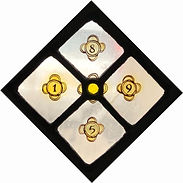
Window 2: The Resurrection
The second window in the Creation and the New Creation series of windows at the church of
Saints Leonard and Fergus, Dundee.
While Window 2: The Resurrection is visually one of the simplest windows of the series, it is also one of the richest in terms of its symbolism.
Jesus’s Resurrection comes at the end of his earthly ministry, three days after his death, so it might initially seem strange that it appears so early in this series of windows. Similarly strange, perhaps, is that the window that follows features the final sacrament, the Last Rites. However, taken together, both windows symbolise the beginning of the New Creation, in that the end of earthly life is really the beginning of eternal life. The Resurrection marked the beginning of a new heavenly life for Jesus after his death and the Last Rites sacrament is performed to mark not only the end of earthly life but to heal and strengthen the dying Christian and prepare them for a new eternal life in Christ.
Taken together, we get the first sense in this series of windows of the way themes and ideas overlap with one another. Window 2 represents both the first day of Creation in which God created light, and Jesus’s Resurrection. The light of the first day of Creation extends into Window 3 which overlaps with the final sacrament, the Last Rites. Creation and the New Creation come together to start their intertwined journey throughout the windows.
In the Christian story, Jesus’s Resurrection is celebrated on Easter Sunday and is, for Christians, regarded as the defining event of God’s New Creation. The symbol of the Resurrection is the Paschal candle, also called the Easter candle, because a new one is lit and blessed every year at Easter. On Maundy Thursday, the Thursday before Easter, all the lights and candles in a church are extinguished, representing the darkness of the world without Christ. The new Paschal candle is ceremonially lit and carried into the darkened church at the Service of Light, marking the beginning of the Easter Vigil on the night of Holy Saturday. It represents the light of the risen Christ and life, coming into the world to dispel darkness and death, which has a clear parallel to the creation of light on the first day of Creation.
A stylised form of the Paschal candle forms the focal point of the main window. The body of the candle, which often displays several symbols, is represented in this window simply by the five grains of incense embedded in the candle which stand for the five wounds of Jesus: the thorns that crowned his head, the spear that was thrust into his side and the three nails that pierced his hands and feet. In the outer four grains are the numbers 1, 9, 8 and 5, together making up the year the windows were installed (1985).

The stylised Paschal candle: a simple candle flame and the five grains of incense representing the five wounds of Jesus.
Window 2: The Resurrection.

Jesus's Resurrection in the transom, based on a medieval illumination found in the thirteenth century manuscript, the York Psalter.
The candle flame is portrayed as a central golden diamond of candlelight. The light emanating from the flame is expressed in a mixture of tinted whites against greys and blues, arranged in the Celtic-style latticed pattern that forms the backdrop to all the windows from this one onwards. The light spreads out sideways into the empty cool greys and blues of Window 1 on its left and into the more powerful, deeper blues of Window 3 on its right.
In the transom is a scene of Jesus’s Resurrection based on an illumination from the thirteenth century manuscript, the York Psalter. Dad adapted the background of this scene in line with the Celtic-style latticework in the windows, reflecting the golden yellow candle flame of the Pascal candle in the main window below it.
Dad loves medieval illumination, and many of the painted details in his windows are influenced by medieval artwork. Knowing that the parish was a happy parish, he chose to base his portrayal of the Resurrection on this illumination as a kind of polite joke because in it, the angels on either side of Jesus look like they are happily applauding what has just taken place.
The light of Window 2 extends into Window 3: Last Rites, the next window of the series.
